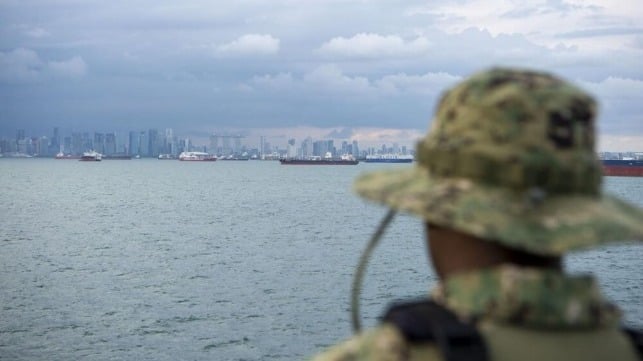A Conflict in the Pacific Could Prompt a Fight Over the Strait of Malacca

[By Adam Leong Kok Wey]
The strategic relevance of maritime choke points has remained a constant throughout military history. Their control has often defined the outcomes of major conflicts, shaped geopolitical balances, and influenced global economic flows.
Exemplifying the enduring value of choke points, this year marks the 110th anniversary of the beginning of the Gallipoli campaign, conducted from February 1915 to January 1916 during the First World War. A joint Anglo-French-Australia-New Zealand force attempted to seize maritime control of the Dardanelles Strait, with amphibious landings to neutralize Ottoman coastal batteries and capture the commanding coastal areas along the Gallipoli Peninsula. This would have enabled Allied naval forces to access the Sea of Marmara and the Bosporus Strait, and subsequently reach the Black Sea.
The failure of this operation, marked by immense casualties, highlights not only the challenges of amphibious and littoral warfare but also the significance of such maritime corridors in determining the strategic fortunes of nations – a sobering reminder of the historical consequences when belligerents seek to control key maritime chokepoints, which includes both maritime and land features.
Today, the strategic calculus surrounding the importance of controlling maritime choke points remains unchanged. In Southeast Asia, the Strait of Malacca represents one of the world’s most critical, congested, and busiest sea lines of communication (SLOCs). The implications of a future conflict on the control of this chokepoint, particularly involving China and Taiwan, and potentially the United States, could be profound.
Maritime choke points are narrow sea lanes that funnel international shipping through constrained passages, often bordered by the sovereign territories of multiple states. These passages, while enabling global trade, are also potential flashpoints in times of tension or conflict. Due to their geographic and economic value, they are vulnerable to interdiction, blockade, or militarization. In the Southeast Asian context, the Strait of Malacca may be considered as the region’s most significant choke point due to its proximity to major regional and extra-regional economies, and a major sea route for the transportation of energy and goods.
The Strait of Malacca, which spans approximately 800 kilometers and ranges in width from 2.7 kilometers to 250 kilometers, serves as the principal maritime corridor linking the Indian Ocean to the Pacific via the South China Sea. Bordered by Peninsular Malaysia to the east and the Indonesian island of Sumatra to the west, it has historically served as a geopolitical magnet, drawing the ambitions of colonial powers such as Portugal, the Netherlands, and Great Britain. It is estimated that over 90,000 merchant vessels pass through the strait annually, transporting nearly 25% of global trade. Its role as a conduit for oil, liquefied natural gas, and manufactured goods underpins the economies of not just Southeast Asia but also East Asia and beyond.
As the balance of power in the Indo-Pacific becomes increasingly contested, the potential for armed conflict – particularly over Taiwan – introduces substantial risks for the Strait of Malacca. In the event of hostilities, this vital choke point would assume strategic importance for the warring parties.
There are several plausible scenarios for how the Strait of Malacca may be affected. Firstly, the belligerents may implement blockades or maritime exclusion zones to restrict or deny access to the strait, similar to those enacted during the 1962 Cuban Missile Crisis or the 1982 Falklands War.
Secondly, hostile forces may conduct sea denial operations such as the mining of strategic points in the strait, the deployment of submarines for interdiction attacks, and the use of anti-ship missiles or drones to strike shipping, which may render the strait impassable.
Thirdly, the belligerents may seek to strike littoral infrastructure – such as ports, refuelling stations and bunkers – using precision long-range weapons. This would not only degrade the operational capabilities but also erode the commercial functionality of critical maritime infrastructure of affected states.
And fourthly, perhaps the highest risk for the strait, the belligerent states may attempt to capture the adjacent littoral land areas straddling the strait to ensure a total control of the waterway. As demonstrated by the Gallipoli campaign, control of the sea is often inextricably linked to control of adjacent land. The seizure or neutralization of littoral territory enables denial of maritime access and facilitates dominance over key sea routes. The littoral zones of Peninsular Malaysia, Sumatra, and Singapore could become targets for temporary strategic occupation or in the worst case scenario, permanent occupation of the land captured. While these maritime choke points’ littoral states may declare neutral stances, it must be underpinned by credible military deterrence and the capacity to fight for control of respective territorial areas.
Prudence demands preparation for worst-case scenarios. The unpredictability of future conflicts reinforces the necessity for foresight and decisive investments in multi-domain defense capabilities. As Julian Corbett argued, the purpose of sea power is not an end in itself, but a means to influence events on land. In that light, safeguarding maritime choke points by Southeast Asia littoral states must be integrated into a comprehensive, multi-domain strategy involving not only naval power but also land and air power.
Adam Leong Kok Wey, PhD, is professor of strategic studies and director of the Centre for Defence and International Security Studies (CDISS) at the National Defence University of Malaysia (NDUM).
The opinions expressed herein are the author's and not necessarily those of The Maritime Executive.
